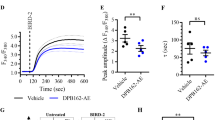Abstract
The role of Ca2+ in the intracellular signal transduction process that causes antibody-induced apoptotic cell death in B-cells is not completely understood. We previously established a B-cell line (MBC-1) from a patient with Burkitt lymphoma at the leukemic stage that demonstrated the typical morphology and internucleosomal DNA fragmentation of apoptosis when treated with anti-immunoglobulin (Ig)M antibody. This antibody-induced cell death was partially inhibited by pretreatment with ethyleneglycol-bis-tetraacetic acid (EGTA) and actinomycin-D. FK506, an immunosupressive agent and calcineurin inhibitor, also partially rescued the anti-IgM antibody—induced death of MBC-1 cells. These results show that the calcium signaling pathway, which leads to a change in gene expression, plays an important role in anti-IgM—induced apoptosis in MBC-1 cells. Flow cytometric measurement of the cytosolic free Ca2+ concentration ([Ca2+]i) showed that nontoxic concentrations of 4-bromo-calcium ionophore A23187 (Ca2+ IP) increased [Ca2+]i more than did the anti-IgM antibody. A brief Ca2+ spike was observed on anti-IgM antibody treatment, but a gradual increase and decrease were observed when the cells were treated with Ca2+ IP at a nontoxic concentration of 1 μg/mL. These findings suggest that interpretations differ for the 2 patterns of calcium signaling and that the brief spiked elevation of Ca2+ produces distinct biological and cellular responses compared to the gradual increase and decrease of [Ca2+]i. Our results support the hypothesis that Ca2+ plays a significant role as a multifunctional second messenger providing specific information to the nucleus in anti-IgM antibody—induced apoptosis in MBC-1 cells.
Similar content being viewed by others
References
Pratt RB, Greene RM. Inhibition of palatal epithelial cell death by altered protein synthesis.Devel Biol. 1976;54:135–145.
Gunji H, Kharbanda S, Kufe D. Induction of internucleosomal DNA fragmentation in human myeloid leukemia cells by 1-β-D- arabinofuranosylcytosine.Cancer Res. 1991;51:741–743.
Shimizu T, Kubota M, Tanizawa A, et al. Inhibition of both etoposide-induced DNA fragmentation and activation of poly(ADP-ribose) synthesis by zinc ion.Biochem Biophy Res Commun. 1990; 169:1172–1177.
Smith CA, Williams GT, Kingston R, Jenkinson EJ, Owen JJT. Antibodies to CD3/T-cell receptor complex induce death by apoptosis in immature T cells in thymic cultures.Nature. 1989;337: 181–184.
Ucker DS. Cytotoxic T. lymphocytes and glucocorticoids activate an endogenous suicide process in target cells.Nature. 1987;327: 62–64.
MacDonald HR, Lees RK. Programmed death of autoreactive thymocytes.Nature. 1990;343:642–644.
McConkey DJ, Hartzell P, Amador-Perez JD, Orrenius S, Jondal M. Calcium-dependent killing of immature thymocytes by stimulation via the CD3/T cell receptor complex.J Immunol. 1989;143: 1801–1806.
Fruman DA, Mather PE, Burakoff SJ, Bierer BE. Correlation of calcineurin phosphatase activity and programmed cell death in murine T cell hybridomas.Eur J Immunol. 1992;22:2513–2517.
Okada C, Kizaki H, Tadakuma T. T cell receptor-mediated DNA fragmentation and cell death in T cell hybridomas.J Immunol. 1990;144:2096–2101.
Flanagan WM, Corthesy B, Bram RJ, Crabtree GR. Nuclear association of a T-cell transcription factor blocked by FK-506 and cyclosporin A.Nature. 1991;352:803–807.
Timmerman LA, Clipstone NA, Ho SN, Northrop JP, Crabtree GR. Rapid shuttling of NF-AT in discrimination of Ca2+ signals and immunosuppression.Nature. 1996;383:837–840.
Reth M. Antigen receptors on B lymphocytes.Annu Rev Immunol. 1992;10:97–121.
Saouaf SJ, Mahajan S, Rowley RB, et al. Temporal differences in the activation of three classes of non-transmembrane protein tyrosine kinases following B-cell antigen receptor surface engagement.Proc Natl Acad Sci U S A. 1994;91:9524–9528.
Rawlings DJ. Bruton’s tyrosine kinase controls a sustained calcium signal essential for B lineage development and function.Clin Immunol. 1999;91:243–253.
Kurosaki T, Maeda A, Ishiai M, Hashimoto A, Inabe K,Takata M. Regulation of the phospholipase C-γ2 pathway in B cells.Immunol Res. 2000;176:19–29.
Dolmetsch RE, Lewis RS, Goodnow CC, Healy JI. Differential activation of transcription factors induced by Ca2+ response amplitude and duration.Nature. 1997;386:855–858.
Komada Y, Zhang XL, Zhou YW, et al. Apoptotic cell death induced by anti-IgM antibody and phorbol esters is inhibited by interleukin-4 in human B lymphoma cell line MBC-1.Cellular Immunol. 1994;159:280–293.
Pieters R, Leonen AH, Huismans DR, et al.In vitro drug sensitivity of cells from children with leukemia using the MTT assay with improved culture conditions.Blood. 1990;76:2327–2336.
Higashigawa M, Komada Y, Shimono Y, et al. FK506 inhibits anti- IgM antibody-induced apoptosis and 17 kD endonuclease activity in the human B-cell line, MBC-1, established from Burkitt’s lymphoma.Br J Haematol. 1997;99:908–913.
Liu J, Farmer JD Jr, Lane WS, Friedman J, Weissman I, Schreiber SL. Calcineurin is a common target of cyclophilin-cyclosporin A and FKBP-FK506 complexes.Cell. 1991;66:807–815.
Downward J, Graves J, Cantrell D. The regulation and function of p21ras in T cells.Immunol Today. 1992;13:89–92.
Healy JI, Dolmetsch RE, Timmerman LA, et al. Different nuclear signals are activated by the B cell receptor during positive versus negative signaling.Immunity. 1997;6:419–428.
Author information
Authors and Affiliations
Corresponding author
About this article
Cite this article
Higashigawa, M., Komada, Y. Role of Ca2+ in the Intracellular Signaling Pathway of Anti-IgM—Induced Apoptosis in the Human B-Cell Line, MBC-1, Established from Burkitt Lymphoma. Int J Hematol 76, 44–49 (2002). https://doi.org/10.1007/BF02982717
Received:
Revised:
Accepted:
Published:
Issue Date:
DOI: https://doi.org/10.1007/BF02982717




